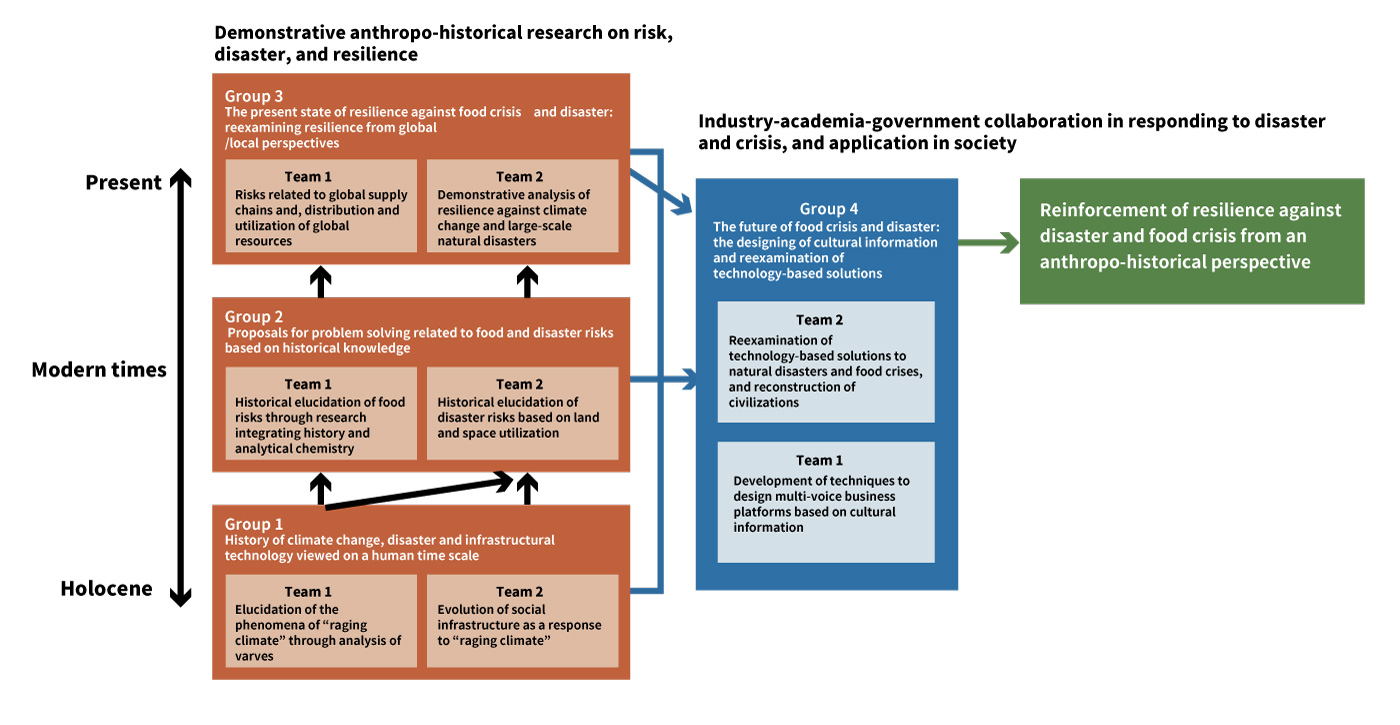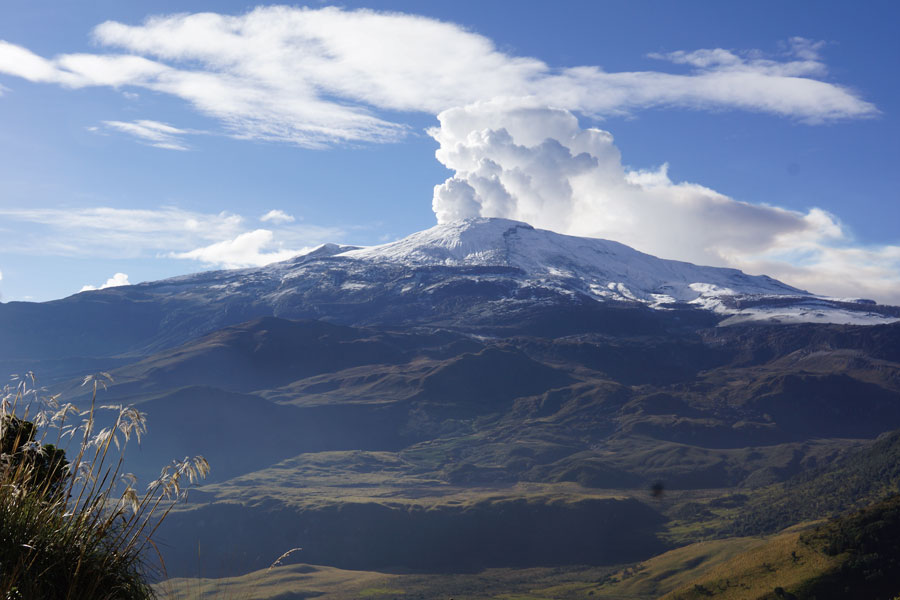Research AreaⅡ Overcoming natural disastersInterdisciplinary Research Hub for Resilience Engineering: Thinking Disaster and Food Crisis from History of Humanity
Creating a highly resilient society in the face of disasters, food crisis, and other major threats
Leaders
-
-
Group leaderTakeshi NakagawaProfessor, Research Center for Palaeoclimatology, Research Organization of Science and TechnologyProfile
-
Group leaderKaoru KamataniProfessor, Department of Gastronomy Management, College of Gastronomy ManagementProfile
-
Group leaderNoboru MiyawakiProfessor, Department of Policy Science, College of Policy ScienceProfile
R-GIRO dedicated researcher
Elucidating the mechanisms of disaster and food crisis and human responses, to identify conditions and measures for reinforcing resilience in society
Increasingly frequent natural disasters related to climate change, coupled with the prolonged pandemic, have intensified a sense of crisis in society, while the development of artificial intelligence and other technological advances make it harder than ever to define a clear future vision for humankind. Growing human vulnerability in the face of natural disasters, food crises, and other major threats has been covered in a number of studies in recent years, with the history of humankind delineated with major turning points such as the Agricultural Revolution and the Industrial Revolution. However, studies founded on disciplines such as archaeology, anthropology, and linguistics tend to lack the technical perspective required to align anthropo-historical enterprises with present-day issues. On the other hand, technologically-oriented research tends to lack a deep understanding of nature and humankind from a perspective generally found in humanities research. Therefore, this project, set in the context of environmental characteristics and distinctive civilizations of the Pacific Rim, is informed by findings from past solid demonstrative research on climate change, disaster, and food crisis in the disciplines of paleoclimatology, archaeology, geography, history, and anthropology, and it is pursued in collaboration with researchers specializing in resource geopolitics, technology management, information engineering, management technology, and urban policy, for the purpose of formulating practically implementable proposals to reinforce resilience in human society against present-day disasters and threats.
-

Research results envisaged in the project
Building multi-voiced business platform to share research findings in empirical study on history of humanity for disaster and crisis resilience
This project aims at creating a new academic discipline that makes practical proposals regarding responses to current and future disaster risks and food crises, based on findings to be obtained in elucidating the “disaster/crisis civilization,” so to speak, of the Pacific Rim, which has developed through numerous disasters, while surveying the evolution of humankind, the natural environment, and human society from a very long-term perspective. The project draws its strength from its interdisciplinary unifying ability to enable the project members to conduct humanities and social science research on the foundation of demonstrative natural sciences. The project thus intends to benefit society with its results through design formulation and practical application using capabilities in the domain of technology management.
The project is pursued by four groups of researchers. Firstly, the Nakagawa Group, which specializes in paleoclimatology, is charged with the reconstruction of climate change over the last several thousand years by using a technology that extracts pure pollen fossils from varve sediments to radiocarbon-date and measure stable isotope ratios, and the world’s most advanced system that analyzes the chemical composition of varve sediments at a 10-micron resolution. (Ritsumeikan University’s Research Center for Palaeoclimatology was the first in the world to develop these technologies for practical application.) Concretely, the group is reconstructing the change in climate stability over the last tens of thousands of years observed in units of several years to several decades, based on high-precision analysis of the varves of Lake Suigetsu in Fukui Prefecture, recognized as a global standard scale for dating. The group is also reconstructing the climate stability over the last 3,000 years or so in units of several weeks to several years, based on varves in the Maya region in Latin America, to combine the analysis results with archaeological knowledge to clarify how the change in climate stability affected the Maya civilization. The group is also conducting a transversal study covering many past periods to compare Japan and Peru, which differ in terms of climate and natural disasters, to examine the history of water distribution systems in each country, such as waterways, dams, rivers, and reservoirs, to demonstratively clarify the transformation of the infrastructure as responses to “raging climate” phenomena (drastic events repeated within a relatively short period), especially droughts, floods, earthquakes, and other such natural disasters, as well as to explore ways to use traditional water distribution systems in present-day society.
The Kamatani Group surveys food- and disaster-related risks from a historical perspective to propose problem-solving methodologies by applying historical knowledge in examining risks in present-day issues. To this end, the group is working to clarify changes in food production in modern Japan through analysis of historical documents: the daily diet and nutritional situation in the Edo period will be inferred, based on stable carbon and nitrogen isotope analysis and PIXY multi-elemental analysis of Edo-period human hair samples retaining surplus nutrients and toxins. Food shortages and nutritional risks due to natural disasters and famines will be thus assessed and analyzed. The group will also draw up disaster risk maps of several areas based on seismic data, as well as GIS maps, by collating disaster-related information and paleoenvironmental changes obtained from archaeological records with demographic data to clarify the relationship between long-term environmental and demographic changes. Moreover, by focusing on the interaction between natural disasters due to climate change and food-related risks, the group will analyze food- and disaster-related risks that can emerge in the future, drawing up a food/disaster atlas comprising charts, diagrams, and maps indicating the historical evolution of food-related events and disasters and future prospects.
While the Nakagawa and Kamatani Groups are concerned with disasters, food crises, and human activities in the past, the Miyawaki Group is concerned with two major present-day themes related to disaster and food crisis. Firstly, the group examines risks related to the stability and sustainability of global supply chains of food and other resources from a broad perspective encompassing the sustainability of trunk roads, airports, and internet circuits in terms of not only infrastructural construction but also the essential role of international cooperation in enhancing connectivity, thus clarifying the possibilities for local food supply systems and problems in the current situation. The aim is to explore ways to subject limited global resources to more balanced distribution and utilization and integrate such approaches into policy design for a space enabling peaceful coexistence in Asia. Secondly, the group is using cases in the Pacific Rim as examples to examine how people use societal and cultural means to respond to ever-evolving Nature, as attested by climate change and large-scale natural disasters, in an attempt to overcome ecological crises, to explore ways to reinforce society’s responsiveness to and resilience against danger.
The Ogawa Group is charged with the development of techniques to design community-dependent, multi-voice business platforms while taking into consideration the cultural information to be obtained from research by the other three groups. The Ogawa Group will visualize research findings by the other three groups by GIS and other means to develop a geospatial information platform on the human history of resilience. This tool for building a highly disaster-resistant society can be described as a cross between technological problem solving, such as AI-aided automation, and human culture-based problem solving emphasizing traditionally nurtured local wisdom and mentality. This platform should enable resilience-reinforcing policy measures to be formulated and examined vis-à-vis the strengths and weaknesses of a given locale, based on the modelization of interconnections of technological problem-solving behavior, mentality, and their manifestations, incorporating elements not found in current hazard maps for assessing resilience against various forms of crisis, such as natural disasters, food shortages, and demographic change, which differ from one locale to another; changes in land use by humans rendering the natural environment more dangerous and the wisdom of human activities that have evaded danger (research results by the Nakagawa and Kamatani Groups); and the mechanisms of global-local cooperation and resource distribution that can determine the consequences (aggravation or recovery) of a disaster in a specific locale (addressed by the Miyawaki Group). The group will also survey the knowledge thus obtained and collate it with case studies of technology-based responses to disaster and food crisis by local governments, communities, and businesses in Japan and other Asian countries, to benefit society through the application of research results involving the above-mentioned approaches and the platform.
-

Volcanic eruption in Chile (the Pacific Rim has a high degree of risk of volcanic eruptions)
Natural sciences, social sciences, humanities, and technology united to combat disaster and food crisis
As places where project results will be put to practical use to benefit society, overseas ministerial agencies and governmental organizations with which Ritsumeikan University’s Research Center for Pan-Pacific Civilizations are associated, projects related to Expo 2025 Osaka, Kansai, in which Ritsumeikan University will participate as a partner, and the Sustainable Community Economy project of Trust Capital Foundation are listed as candidates. To respond to global warming, environmental destruction, disaster, and food crisis, it is necessary to devise immediate solutions and plans drawn up from a very long-term perspective spanning several decades and even centuries into the future, taking into account the land and climate characteristics and the economic and political vulnerability of the target locale. In view of this, it can be said that the ultimate goal of this project is to have its original results effectively applied so as to obtain international recognition for the significance of research integrating natural sciences, social sciences, humanities, and technology in combating disaster and food crisis.
077-561-3488 (9:00-17:30 on weekdays)
072-665-2570 (9:00-17:30 on weekdays)
075-465-8224 (9:00-17:30 on weekdays)
